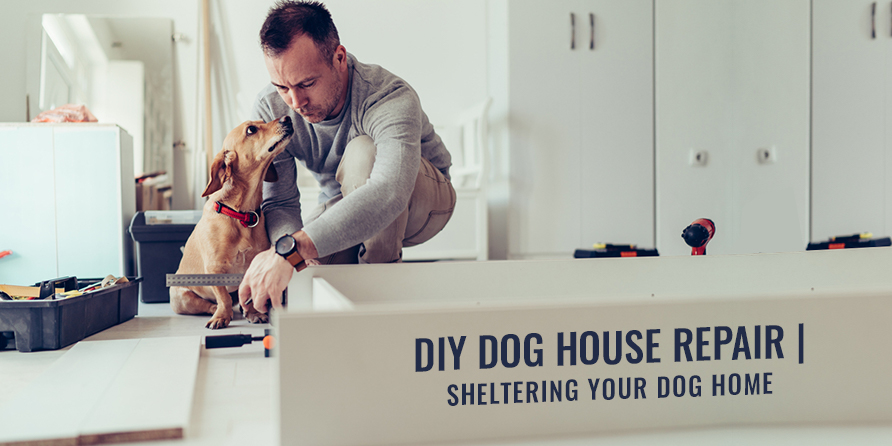DIY Dog House Repair: Sheltering Your Dog Home

Our fur-babies reside in the house with us as family members, but we occasionally leave a dog house in the yard to give our pooch options. Whatever way we choose to showcase our canine companions garden suite, it will require some maintenance from time to time. Fortunately, it’s National Dog House Repair Month, and these techniques will give that old eyesore a much-needed facelift suitable for a fur-king.
The Outdoor Getaway
An outside dog home is frequently a Scooby doo dog retreat in the shade with a rooftop sunning option or cool rest place in the shade. Because they are exposed to the elements, these dog houses are the most prone to deterioration over time. Roofs have the potential to bend and leak. Floors can get filthy and moldy. The month of dog home repair is an excellent time to do an overall evaluation. We can build a new one, repair old ones, or add finishing touches to transform it from a weathered eye pain into a lovely doggy haven.
The Indoor Hideout
We normally think of outdoor doghouses when we hear the word “doghouse.” Believe it or not, many individuals prefer to build an indoor space for their dog to hide when they need a haven away from children or a peaceful spot. This is especially beneficial for senior dogs, those who suffer from anxiety, and those who live in a family with little children. Indoor dog houses are getting increasingly sophisticated. All we actually need is a box and a blanket, but the possibilities are endless. If repairs aren’t required, there’s no shortage of ideas for improvements. Such as:
- There are motion sensors that will activate a small fan to keep our pooch cool and comfortable while he escapes the summer heat.
- There are enhancements that will play music quietly so that our pets can have some comfort when the family is away.
- There are also pedals that may be added to release a treat when our dog is hungry.
[Also Read] Common Signs of Anxiety in Dogs
Dog House Repair Month: A Five-Point Checklist
1. Dimensions
Puppies should be able to turn around comfortably inside their hideaway. They’ll use it to get away from the heat, so they’ll be able to rest flat without having to hang outside the home. It should also be small enough for them to curl up and use their body heat to warm the area. The space should be snug yet readily aired, thus it should be tall enough for them to stand up and have air flow, but low enough that it is not draughty.
2. Location
A dog house is a refuge. We can assess the area for all-day sun protection. Rain and extreme cold can get inside dog houses, but it’s far worse when the wind blows it in through the door. This month is ideal for constructing a windbreak or reorienting the dog house. If you’re concerned about safety, cut out the back of the doghouse and place it against the dog door to the main house. That way, the dogs can get in and out of the house without most people noticing.
3. Structures
Because plastic, fiberglass, and metal can become excessively hot, wood is frequently the material of choice. Just make sure you avoid using treated wood. It includes arsenic and other substances that can be hazardous to our dogs in the long run, especially if they gnaw on the siding. Drilling a few holes on the tops of the walls, behind the eaves, will keep the rain out while allowing ventilation. To avoid mould and penetrating cold, doghouses should be waterproof. They should be insulated as well to assist keep the heat in during cold spells.
4. The Roof
A flat roof with a small ladder is a crowd-pleaser that allows our pups to enjoy the afternoon breezes in Snoopy fashion. If it’s flat, make sure there’s a slant so rain and debris don’t settle. Hinged roofs need a bit more effort, but they are well worth it. It may not be a daily occurrence to be able to effortlessly remove the top to clean out the house and replace bedding, but it undoubtedly makes the job easier and faster. Plus, it will be easy to check on our canine companion if he becomes ill and decides to go to his hideaway rather than trying to lean through the door.
5. Ground
It is best to ensure that the ground is elevated. When the home needs to be relocated to prevent wind and rain from entering through the door, installing wheels could be a terrific option to lift the house. Because air circulates in raised dog houses, dogs stay cooler in the summer. In addition, because the floor is dry, a raised floor helps keep the ground warm in cold weather.
Further Reading
Because our pups are family and live in the main house with us, it’s easy to forget about keeping up the dog house, but having a dog house as a retreat means it’s clean, pleasant all year round, and provides a peaceful hideaway for canines who suffer from anxiety. Let’s take a day, a weekend, or just a few hours this dog house repair month to give our fur-babies the best possible home away from home.

David joined CanadaVetCare in 2013 as a product analyst and veterinary assistant. Being a passionate pet lover and keen animal health researcher, David had always found ways and solutions to help pet parents to improve their pets’ health. He is always happy to answer pet health-related queries and recommending pet parents for the right pet product for their furry companions.

